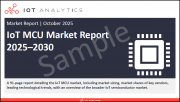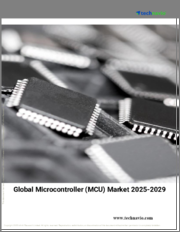
|
시장보고서
상품코드
1754198
IoT 마이크로컴퓨터 시장 보고서 : 제품, 용도, 지역별(2025-2033년)IoT Microcontroller Market Report by Product (8 Bit, 16 Bit, 32 Bit), Application (Industrial Automation, Smart Homes, Consumer Electronics, and Others), and Region 2025-2033 |
||||||
세계의 IoT 마이크로컴퓨터 시장 규모는 2024년에 63억 달러에 달했습니다. 향후 IMARC Group은 시장이 2033년까지 125억 달러에 달하며, 2025-2033년의 성장률(CAGR)은 7.63%에 달할 것으로 예측하고 있습니다.
사물인터넷(IoT) 마이크로컨트롤러는 하나의 집적회로(IC)에 내장된 소형의 독립형 제어장비로, 스마트폰, 리모컨, 사무기기, 의료, 산업기기, 창고 재고, 웨어러블 기기, 가전제품 등에 널리 사용되고 있습니다. IoT 마이크로컨트롤러는 스마트폰, 리모컨, 사무기기, 의료장비, 산업장비, 창고 재고품, 웨어러블 기기, 가전제품 등에 널리 사용되고 있으며, 최소한의 프로그래밍이 필요하고, 외부 기기와의 인터페이스가 용이하며, 보안이 강화된 IoT 마이크로컨트롤러는 처리 능력, 메모리, 입출력 주변기기를 제공합니다. 처리능력, 메모리, 입출력 주변기기를 제공하는 소형 컴퓨터입니다. 그 결과, IoT 마이크로컨트롤러는 가전, 자동차, 산업, 스마트홈, 헬스케어 산업 등 다양한 용도로 활용되고 있습니다.
IoT 마이크로컨트롤러 시장 동향 :
스마트 기기의 급속한 보급과 함께 전 세계에서 IoT 연결의 채택이 증가하고 있는 것은 시장 성장을 이끄는 주요 요인 중 하나이며, IoT 마이크로컨트롤러는 스마트폰, 웨어러블, 온도 조절기, 조명, 스피커, 냉장고 등에 광범위하게 사용되고 있습니다. 비교적 간단하고, 내재된 보안이 향상되고, 비용이 최소화되어 있기 때문입니다. 또한 자동차 산업에서는 센서, 안테나, 통신 장비, 스마트 엔진 제어, 임베디드 소프트웨어에 의존하는 커넥티드 차량 기술의 제품 활용이 확대되고 있으며, 시장 성장을 크게 촉진하고 있습니다. 또한 하이최종 용도를 위한 IoT 마이크로컨트롤러에 내장형 비휘발성 메모리(eNVM)가 통합되어 전력 소비를 줄이고, 속도, 내구성, 효율성을 향상시키면서 시장 전망을 밝게 하고 있습니다. 또한 전동 공구, 사무기기, 스마트 거울, 난방 시스템, 보안 경보, 스마트 미터, 주방 가전, 엔터테인먼트 시스템 등 가정용 및 산업용 자동화 제품의 사용이 증가하고 있는 것도 시장 성장에 탄력을 받고 있습니다. 기타 IoT 기술의 큰 발전, 헬스케어 산업에서의 제품 사용 증가, 전체 전기 에너지 소비를 모니터링하기 위한 스마트 미터의 급속한 설치, 클라우드, 빅데이터, 가상화 채택 증가 등이 시장 성장의 원동력이 될 것으로 예측됩니다.
이 보고서에서 다룬 주요 질문
- 2024년 세계 IoT 마이크로컨트롤러 시장 규모는?
- 2025-2033년 세계 IoT 마이크로컨트롤러 시장 성장률 전망은?
- 세계의 IoT 마이크로컨트롤러 시장을 주도하는 주요 요인은?
- COVID-19가 세계의 IoT 마이크로컨트롤러 시장에 미치는 영향은?
- 세계의 IoT 마이크로컨트롤러 시장에서의 제품별 분류는?
- 세계의 IoT 마이크로컨트롤러 시장 용도별 분류는?
- 세계의 IoT 마이크로컨트롤러 시장 주요 지역은?
- 세계의 IoT 마이크로컨트롤러 시장의 주요 기업은?
목차
제1장 서문
제2장 조사 범위와 조사 방법
- 조사의 목적
- 이해관계자
- 데이터 소스
- 1차 정보
- 2차 정보
- 시장 추정
- 보텀업 어프로치
- 톱다운 어프로치
- 조사 방법
제3장 개요
제4장 서론
- 개요
- 주요 업계 동향
제5장 세계의 IoT 마이크로컴퓨터 시장
- 시장 개요
- 시장 실적
- COVID-19의 영향
- 시장 예측
제6장 시장 내역 : 제품별
- 8비트
- 16비트
- 32비트
제7장 시장 내역 : 용도별
- 산업 자동화
- 스마트홈
- CE(Consumer Electronics)
- 주요 부문
- 스마트폰
- 웨어러블
- 기타
- 주요 부문
- 기타
제8장 시장 내역 : 지역별
- 북미
- 미국
- 캐나다
- 아시아태평양
- 중국
- 일본
- 인도
- 한국
- 호주
- 인도네시아
- 기타
- 유럽
- 독일
- 프랑스
- 영국
- 이탈리아
- 스페인
- 러시아
- 기타
- 라틴아메리카
- 브라질
- 멕시코
- 기타
- 중동 및 아프리카
- 시장 내역 : 국가별
제9장 SWOT 분석
- 개요
- 강점
- 약점
- 기회
- 위협
제10장 밸류체인 분석
제11장 Porter's Five Forces 분석
- 개요
- 바이어의 교섭력
- 공급 기업의 교섭력
- 경쟁의 정도
- 신규 진출업체의 위협
- 대체품의 위협
제12장 가격 분석
제13장 경쟁 구도
- 시장 구조
- 주요 기업
- 주요 기업의 개요
- Broadcom Inc
- Espressif Systems
- Holtek Semiconductor Inc.
- Infineon Technologies
- Intel Corporation
- Microchip Technology Inc.
- Nuvoton Technology Corporation
- NXP Semiconductors
- Renesas Electronics Corporation
- Silicon Laboratories
- STMicroelectronics
- Texas Instruments Incorporated
The global IoT microcontroller market size reached USD 6.3 Billion in 2024. Looking forward, IMARC Group expects the market to reach USD 12.5 Billion by 2033, exhibiting a growth rate (CAGR) of 7.63% during 2025-2033.
Internet of Things (IoT) microcontrollers are small, self-contained control units incorporated in a single integrated circuit (IC). They are widely used in smartphones, remote controls, office machines, medical devices, industrial equipment, warehouse inventory items, wearable devices, and home appliances. IoT microcontrollers require minimum programming, are easy to interface with external devices, and offer enhanced security. They are scaled-down computers that provide processing power, memory, and input and output peripherals. As a result, IoT microcontrollers find extensive applications across the consumer electronics, automotive, industrial, smart homes, and healthcare industries.
IoT Microcontroller Market Trends:
The increasing adoption of IoT connections across the globe, coupled with the rapid proliferation of smart devices, is one of the key factors favoring the market growth. IoT microcontroller is widely used in smartphones, wearables, thermostats, lights, speakers, and refrigerators due to their relative simplicity, increased inherent security, and minimal cost. Furthermore, the widespread product utilization in the automotive industry for connected vehicle technology that relies on sensors, antennas, communication devices, smart engine controls, and embedded software is providing a considerable boost to the market growth. Additionally, the integration of embedded non-volatile memory (eNVM) in IoT microcontrollers for high-end applications, as it helps lower power consumption and provides higher speed, better endurance, and increased efficiency, is creating a positive outlook for the market. Moreover, the rising product utilization for home and industrial automation, such as power tools, office machines, smart mirrors, heating systems, security alarms, smart meters, kitchen appliances, and entertainment systems, is providing an impetus to the market growth. Other factors, including significant advancements in the IoT technology, rising product utilization in the healthcare industry, rapid installation of smart meters to monitor overall electrical energy consumption, and increasing adoption of cloud, big data, and virtualization, are anticipated to drive the market growth.
Key Market Segmentation:
Breakup by Product:
- 8 Bit
- 16 Bit
- 32 Bit
Breakup by Application:
- Industrial Automation
- Smart Homes
- Consumer Electronics
- Smartphones
- Wearables
- Others
- Others
Breakup by Region:
- North America
- United States
- Canada
- Asia-Pacific
- China
- Japan
- India
- South Korea
- Australia
- Indonesia
- Others
- Europe
- Germany
- France
- United Kingdom
- Italy
- Spain
- Russia
- Others
- Latin America
- Brazil
- Mexico
- Others
- Middle East and Africa
Competitive Landscape:
The competitive landscape of the industry has also been examined along with the profiles of the key players being Broadcom Inc, Espressif Systems, Holtek Semiconductor Inc., Infineon Technologies, Intel Corporation, Microchip Technology Inc., Nuvoton Technology Corporation, NXP Semiconductors, Renesas Electronics Corporation, Silicon Laboratories, STMicroelectronics and Texas Instruments Incorporated.
Key Questions Answered in This Report
- 1.What was the size of the global IoT microcontroller market in 2024?
- 2.What is the expected growth rate of the global IoT microcontroller market during 2025-2033?
- 3.What are the key factors driving the global IoT microcontroller market?
- 4.What has been the impact of COVID-19 on the global IoT microcontroller market?
- 5.What is the breakup of the global IoT microcontroller market based on the product?
- 6. What is the breakup of the global IoT microcontroller market based on the application?
- 7.What are the key regions in the global IoT microcontroller market?
- 8.Who are the key players/companies in the global IoT microcontroller market?
Table of Contents
1 Preface
2 Scope and Methodology
- 2.1 Objectives of the Study
- 2.2 Stakeholders
- 2.3 Data Sources
- 2.3.1 Primary Sources
- 2.3.2 Secondary Sources
- 2.4 Market Estimation
- 2.4.1 Bottom-Up Approach
- 2.4.2 Top-Down Approach
- 2.5 Forecasting Methodology
3 Executive Summary
4 Introduction
- 4.1 Overview
- 4.2 Key Industry Trends
5 Global IoT Microcontroller Market
- 5.1 Market Overview
- 5.2 Market Performance
- 5.3 Impact of COVID-19
- 5.4 Market Forecast
6 Market Breakup by Product
- 6.1 8 Bit
- 6.1.1 Market Trends
- 6.1.2 Market Forecast
- 6.2 16 Bit
- 6.2.1 Market Trends
- 6.2.2 Market Forecast
- 6.3 32 Bit
- 6.3.1 Market Trends
- 6.3.2 Market Forecast
7 Market Breakup by Application
- 7.1 Industrial Automation
- 7.1.1 Market Trends
- 7.1.2 Market Forecast
- 7.2 Smart Homes
- 7.2.1 Market Trends
- 7.2.2 Market Forecast
- 7.3 Consumer Electronics
- 7.3.1 Market Trends
- 7.3.2 Key Segments
- 7.3.2.1 Smartphones
- 7.3.2.2 Wearables
- 7.3.2.3 Others
- 7.3.3 Market Forecast
- 7.4 Others
- 7.4.1 Market Trends
- 7.4.2 Market Forecast
8 Market Breakup by Region
- 8.1 North America
- 8.1.1 United States
- 8.1.1.1 Market Trends
- 8.1.1.2 Market Forecast
- 8.1.2 Canada
- 8.1.2.1 Market Trends
- 8.1.2.2 Market Forecast
- 8.1.1 United States
- 8.2 Asia-Pacific
- 8.2.1 China
- 8.2.1.1 Market Trends
- 8.2.1.2 Market Forecast
- 8.2.2 Japan
- 8.2.2.1 Market Trends
- 8.2.2.2 Market Forecast
- 8.2.3 India
- 8.2.3.1 Market Trends
- 8.2.3.2 Market Forecast
- 8.2.4 South Korea
- 8.2.4.1 Market Trends
- 8.2.4.2 Market Forecast
- 8.2.5 Australia
- 8.2.5.1 Market Trends
- 8.2.5.2 Market Forecast
- 8.2.6 Indonesia
- 8.2.6.1 Market Trends
- 8.2.6.2 Market Forecast
- 8.2.7 Others
- 8.2.7.1 Market Trends
- 8.2.7.2 Market Forecast
- 8.2.1 China
- 8.3 Europe
- 8.3.1 Germany
- 8.3.1.1 Market Trends
- 8.3.1.2 Market Forecast
- 8.3.2 France
- 8.3.2.1 Market Trends
- 8.3.2.2 Market Forecast
- 8.3.3 United Kingdom
- 8.3.3.1 Market Trends
- 8.3.3.2 Market Forecast
- 8.3.4 Italy
- 8.3.4.1 Market Trends
- 8.3.4.2 Market Forecast
- 8.3.5 Spain
- 8.3.5.1 Market Trends
- 8.3.5.2 Market Forecast
- 8.3.6 Russia
- 8.3.6.1 Market Trends
- 8.3.6.2 Market Forecast
- 8.3.7 Others
- 8.3.7.1 Market Trends
- 8.3.7.2 Market Forecast
- 8.3.1 Germany
- 8.4 Latin America
- 8.4.1 Brazil
- 8.4.1.1 Market Trends
- 8.4.1.2 Market Forecast
- 8.4.2 Mexico
- 8.4.2.1 Market Trends
- 8.4.2.2 Market Forecast
- 8.4.3 Others
- 8.4.3.1 Market Trends
- 8.4.3.2 Market Forecast
- 8.4.1 Brazil
- 8.5 Middle East and Africa
- 8.5.1 Market Trends
- 8.5.2 Market Breakup by Country
- 8.5.3 Market Forecast
9 SWOT Analysis
- 9.1 Overview
- 9.2 Strengths
- 9.3 Weaknesses
- 9.4 Opportunities
- 9.5 Threats
10 Value Chain Analysis
11 Porters Five Forces Analysis
- 11.1 Overview
- 11.2 Bargaining Power of Buyers
- 11.3 Bargaining Power of Suppliers
- 11.4 Degree of Competition
- 11.5 Threat of New Entrants
- 11.6 Threat of Substitutes
12 Price Analysis
13 Competitive Landscape
- 13.1 Market Structure
- 13.2 Key Players
- 13.3 Profiles of Key Players
- 13.3.1 Broadcom Inc
- 13.3.1.1 Company Overview
- 13.3.1.2 Product Portfolio
- 13.3.1.3 Financials
- 13.3.1.4 SWOT Analysis
- 13.3.2 Espressif Systems
- 13.3.2.1 Company Overview
- 13.3.2.2 Product Portfolio
- 13.3.2.3 Financials
- 13.3.3 Holtek Semiconductor Inc.
- 13.3.3.1 Company Overview
- 13.3.3.2 Product Portfolio
- 13.3.3.3 Financials
- 13.3.4 Infineon Technologies
- 13.3.4.1 Company Overview
- 13.3.4.2 Product Portfolio
- 13.3.4.3 Financials
- 13.3.4.4 SWOT Analysis
- 13.3.5 Intel Corporation
- 13.3.5.1 Company Overview
- 13.3.5.2 Product Portfolio
- 13.3.5.3 Financials
- 13.3.5.4 SWOT Analysis
- 13.3.6 Microchip Technology Inc.
- 13.3.6.1 Company Overview
- 13.3.6.2 Product Portfolio
- 13.3.6.3 Financials
- 13.3.6.4 SWOT Analysis
- 13.3.7 Nuvoton Technology Corporation
- 13.3.7.1 Company Overview
- 13.3.7.2 Product Portfolio
- 13.3.7.3 Financials
- 13.3.8 NXP Semiconductors
- 13.3.8.1 Company Overview
- 13.3.8.2 Product Portfolio
- 13.3.8.3 Financials
- 13.3.8.4 SWOT Analysis
- 13.3.9 Renesas Electronics Corporation
- 13.3.9.1 Company Overview
- 13.3.9.2 Product Portfolio
- 13.3.9.3 Financials
- 13.3.9.4 SWOT Analysis
- 13.3.10 Silicon Laboratories
- 13.3.10.1 Company Overview
- 13.3.10.2 Product Portfolio
- 13.3.10.3 Financials
- 13.3.11 STMicroelectronics
- 13.3.11.1 Company Overview
- 13.3.11.2 Product Portfolio
- 13.3.11.3 Financials
- 13.3.11.4 SWOT Analysis
- 13.3.12 Texas Instruments Incorporated
- 13.3.12.1 Company Overview
- 13.3.12.2 Product Portfolio
- 13.3.12.3 Financials
- 13.3.12.4 SWOT Analysis
- 13.3.1 Broadcom Inc
















